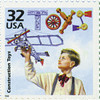
1998 32c Celebrate the Century,1910s: Construction Toys
# 3183n - 1998 32c Celebrate the Century - 1910s: Construction Toys
$1.95 - $3.20
U.S. #3183n
32¢ Construction Toys
Celebrate the Century – 1910s
32¢ Construction Toys
Celebrate the Century – 1910s
Issue Date: February 3, 1998
City: Washington, DC
Quantity: 12,533,000
Printed By: Ashton-Potter (USA) Ltd
Printing Method: Lithographed
Perforations: 11.5
Color: Multicolored
City: Washington, DC
Quantity: 12,533,000
Printed By: Ashton-Potter (USA) Ltd
Printing Method: Lithographed
Perforations: 11.5
Color: Multicolored
A toy is an object children can play with. Since ancient times, toys have “played” an important role in the nurturing of children. It seems children have a profound need to play with toys – even a simple stick can be transformed by a child’s imagination into a hobbyhorse.
Friedrich Froebel, the German founder of the kindergarten, considered toys to be essential learning tools. He believed young children learned not through formal instruction, but through play and imitation. To promote learning, Froebel created learning toys designed to stimulate the imagination. These included a collection of geometric playthings he believed could help children perceive the physical world.
In the second decade of the 20th century, toy manufacturers began to provide children with toys that allowed them to construct the products of their imaginations. With affordable construction toys like Erector sets, Tinkertoys, and Lincoln Logs, miniature homes could be built and machines created – practically anything a child wanted could be assembled.
Interestingly, the idea for Lincoln Logs originated with John Lloyd Wright, the son of famous architect Frank Lloyd Wright – a possible demonstration of the connection between toys and learning.
U.S. #3183n
32¢ Construction Toys
Celebrate the Century – 1910s
32¢ Construction Toys
Celebrate the Century – 1910s
Issue Date: February 3, 1998
City: Washington, DC
Quantity: 12,533,000
Printed By: Ashton-Potter (USA) Ltd
Printing Method: Lithographed
Perforations: 11.5
Color: Multicolored
City: Washington, DC
Quantity: 12,533,000
Printed By: Ashton-Potter (USA) Ltd
Printing Method: Lithographed
Perforations: 11.5
Color: Multicolored
A toy is an object children can play with. Since ancient times, toys have “played” an important role in the nurturing of children. It seems children have a profound need to play with toys – even a simple stick can be transformed by a child’s imagination into a hobbyhorse.
Friedrich Froebel, the German founder of the kindergarten, considered toys to be essential learning tools. He believed young children learned not through formal instruction, but through play and imitation. To promote learning, Froebel created learning toys designed to stimulate the imagination. These included a collection of geometric playthings he believed could help children perceive the physical world.
In the second decade of the 20th century, toy manufacturers began to provide children with toys that allowed them to construct the products of their imaginations. With affordable construction toys like Erector sets, Tinkertoys, and Lincoln Logs, miniature homes could be built and machines created – practically anything a child wanted could be assembled.
Interestingly, the idea for Lincoln Logs originated with John Lloyd Wright, the son of famous architect Frank Lloyd Wright – a possible demonstration of the connection between toys and learning.










